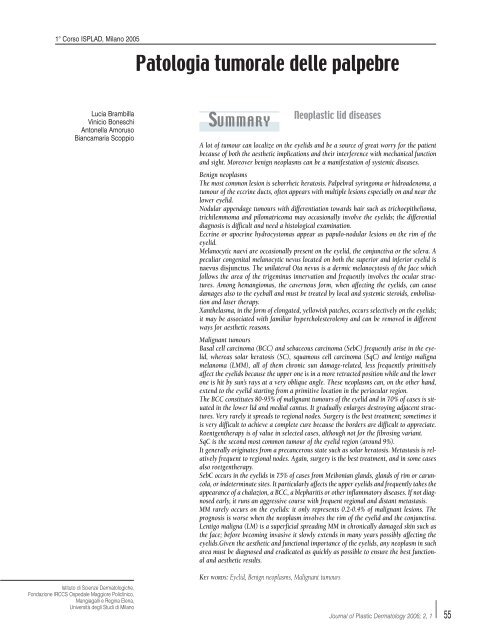Aprile Vol.2 N° 1 - 2006 - Salute per tutti
Aprile Vol.2 N° 1 - 2006 - Salute per tutti
Aprile Vol.2 N° 1 - 2006 - Salute per tutti
Create successful ePaper yourself
Turn your PDF publications into a flip-book with our unique Google optimized e-Paper software.
1° Corso ISPLAD, Milano 2005<br />
Lucia Brambilla<br />
Vinicio Boneschi<br />
Antonella Amoruso<br />
Biancamaria Scoppio<br />
Istituto di Scienze Dermatologiche,<br />
Fondazione IRCCS Ospedale Maggiore Policlinico,<br />
Mangiagalli e Regina Elena,<br />
Università degli Studi di Milano<br />
Patologia tumorale delle palpebre<br />
SUMMARY<br />
Neoplastic lid diseases<br />
A lot of tumour can localize on the eyelids and be a source of great worry for the patient<br />
because of both the aesthetic implications and their interference with mechanical function<br />
and sight. Moreover benign neoplasms can be a manifestation of systemic diseases.<br />
Benign neoplasms<br />
The most common lesion is seborrheic keratosis. Palpebral syringoma or hidroadenoma, a<br />
tumour of the eccrine ducts, often appears with multiple lesions especially on and near the<br />
lower eyelid.<br />
Nodular appendage tumours with differentiation towards hair such as trichoepithelioma,<br />
trichilemmoma and pilomatricoma may occasionally involve the eyelids; the differential<br />
diagnosis is difficult and need a histological examination.<br />
Eccrine or apocrine hydrocystomas appear as papulo-nodular lesions on the rim of the<br />
eyelid.<br />
Melanocytic naevi are occasionally present on the eyelid, the conjunctiva or the sclera. A<br />
peculiar congenital melanocytic nevus located on both the su<strong>per</strong>ior and inferior eyelid is<br />
naevus disjunctus. The unilateral Ota nevus is a dermic melanocytosis of the face which<br />
follows the area of the trigeminus innervation and frequently involves the ocular structures.<br />
Among hemangiomas, the cavernous form, when affecting the eyelids, can cause<br />
damages also to the eyeball and must be treated by local and systemic steroids, embolisation<br />
and laser therapy.<br />
Xanthelasma, in the form of elongated, yellowish patches, occurs selectively on the eyelids;<br />
it may be associated with familiar hy<strong>per</strong>cholesterolemy and can be removed in different<br />
ways for aesthetic reasons.<br />
Malignant tumours<br />
Basal cell carcinoma (BCC) and sebaceous carcinoma (SebC) frequently arise in the eyelid,<br />
whereas solar keratosis (SC), squamous cell carcinoma (SqC) and lentigo maligna<br />
melanoma (LMM), all of them chronic sun damage-related, less frequently primitively<br />
affect the eyelids because the up<strong>per</strong> one is in a more retracted position while and the lower<br />
one is hit by sun’s rays at a very oblique angle. These neoplasms can, on the other hand,<br />
extend to the eyelid starting from a primitive location in the <strong>per</strong>iocular region.<br />
The BCC constitutes 80-95% of malignant tumours of the eyelid and in 70% of cases is situated<br />
in the lower lid and medial cantus. It gradually enlarges destroying adjacent structures.<br />
Very rarely it spreads to regional nodes. Surgery is the best treatment; sometimes it<br />
is very difficult to achieve a complete cure because the borders are difficult to appreciate.<br />
Roentgentherapy is of value in selected cases, although not for the fibrosing variant.<br />
SqC is the second most common tumour of the eyelid region (around 9%).<br />
It generally originates from a precancerous state such as solar keratosis. Metastasis is relatively<br />
frequent to regional nodes. Again, surgery is the best treatment, and in some cases<br />
also roetgentherapy.<br />
SebC occurs in the eyelids in 75% of cases from Meibonian glands, glands of rim or caruncola,<br />
or indeterminate sites. It particularly affects the up<strong>per</strong> eyelids and frequently takes the<br />
appearance of a chalazion, a BCC, a blepharitis or other inflammatory diseases. If not diagnosed<br />
early, it runs an aggressive course with frequent regional and distant metastasis.<br />
MM rarely occurs on the eyelids: it only represents 0.2-0.4% of malignant lesions. The<br />
prognosis is worse when the neoplasm involves the rim of the eyelid and the conjunctiva.<br />
Lentigo maligna (LM) is a su<strong>per</strong>ficial spreading MM in chronically damaged skin such as<br />
the face; before becoming invasive it slowly extends in many years possibly affecting the<br />
eyelids.Given the aesthetic and functional importance of the eyelids, any neoplasm in such<br />
area must be diagnosed and eradicated as quickly as possible to ensure the best functional<br />
and aesthetic results.<br />
KEY WORDS: Eyelid, Benign neoplasms, Malignant tumours<br />
Journal of Plastic Dermatology <strong>2006</strong>; 2, 1 55

















